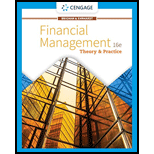
a)
To discuss: Meaning of business risk, capital structure and financial risk.
a)
Explanation of Solution
Capital structure is the combination of debt and equity. Through capital structure it is decided that how much leverage ratio has to be maintained and company decides which sources it will get money and how much volume.
Business risk refers possibility of occurrence of loss due to changes in government policy, taste and preferences of customers that will leads to affect the factors like sales volume, sale price and sales per unit.
Financial risk is the risk where various types of risks associated with this like default risk, in which company sold out item in credit to customer, if customer default in payment or increased the time limit of payment of his cash which ultimately increase the financial risk.
Financial risk might arise due to foreign investment wherever the possibility of risk is higher.
b)
To discuss: Meaning of operating, financial leverages and break-even point.
b)
Explanation of Solution
Operating leverage: It is nothing the degree of change in operating income for percentage change in sales. It is nothing but the ratio of contribution to operating income.
Financial leverage: It is nothing the degree of change in total debt to shareholder’s equity.
Break-even point: It is point where, company has no profit no loss. At break-even point all fixed costs are recovered. It is calculated by using the formula,
c)
To discuss: Reserve borrowing capacity.
c)
Explanation of Solution
It is the capability that company maintain or reserve for future borrowings at the time of good investment arises. Banks are needed to keep cash for uncertain liability and likely the company maintains a reserve borrowing capability to satisfy sensible investment or uncertain liability arises.
Want to see more full solutions like this?
Chapter 15 Solutions
Financial Management: Theory & Practice
- 10. A retirement account earns an annual interest rate of 5%. If you contribute $4,000 per year for 6 years, what will be the total value of the account after 6 years? give me solution..,??arrow_forwardNo AI If an investment grows from $2,000 to $2,500 in three years, what is the compound annual growth rate (CAGR)?arrow_forwardA bond has a face value of $1,000 and a coupon rate of 6%. What is the annual interest payment?need help!!arrow_forward
- 7. If an investment grows from $2,000 to $2,500 in three years, what is the compound annual growth rate (CAGR)? no gpt correct answer no ai ..,??!arrow_forwardA bond has a face value of $1,000 and a coupon rate of 6%. What is the annual interest payment?arrow_forward8. A loan has an annual interest rate of 8% and a principal amount of $15,000. What is the interest payment for the first year? no ai correct answer...??arrow_forward
- 1. If a stock's price increases from $50 to $60, what is the percentage change? no ai gpt..??arrow_forward10. A retirement account earns an annual interest rate of 6%. If you contribute $3,000 per year for 5 years, what will be the total value of the account after 5 years? Let me know..??arrow_forward10. A retirement account earns an annual interest rate of 6%. If you contribute $3,000 per year for 5 years, what will be the total value of the account after 5 years? No directly answarrow_forward
- 1. If a stock's price increases from $50 to $60, what is the percentage change?need help!!!arrow_forward2. A bond has a face value of $1,000 and a coupon rate of 6%. What is the annual interest payment? no ai gpt..??arrow_forward4. A savings account earns an annual interest rate of 4%. If you deposit $2,000, how much interest will you earn in one year? no gpt ai ...???arrow_forward
 Intermediate Financial Management (MindTap Course...FinanceISBN:9781337395083Author:Eugene F. Brigham, Phillip R. DavesPublisher:Cengage Learning
Intermediate Financial Management (MindTap Course...FinanceISBN:9781337395083Author:Eugene F. Brigham, Phillip R. DavesPublisher:Cengage Learning Intermediate Accounting: Reporting And AnalysisAccountingISBN:9781337788281Author:James M. Wahlen, Jefferson P. Jones, Donald PagachPublisher:Cengage LearningPrinciples of Accounting Volume 1AccountingISBN:9781947172685Author:OpenStaxPublisher:OpenStax College
Intermediate Accounting: Reporting And AnalysisAccountingISBN:9781337788281Author:James M. Wahlen, Jefferson P. Jones, Donald PagachPublisher:Cengage LearningPrinciples of Accounting Volume 1AccountingISBN:9781947172685Author:OpenStaxPublisher:OpenStax College
 Auditing: A Risk Based-Approach to Conducting a Q...AccountingISBN:9781305080577Author:Karla M Johnstone, Audrey A. Gramling, Larry E. RittenbergPublisher:South-Western College Pub
Auditing: A Risk Based-Approach to Conducting a Q...AccountingISBN:9781305080577Author:Karla M Johnstone, Audrey A. Gramling, Larry E. RittenbergPublisher:South-Western College Pub





